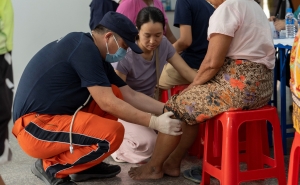Narrower Traffic Lanes in Cities Could Help Lower Risk of Traffic-Related Collisions
Report recommends urban streets with widths of 9 to 10 feet in some instances; lane-width reduction projects can increase walking, cycling, improve overall safety.

A new report from researchers at the Johns Hopkins Bloomberg School of Public Health’s Bloomberg American Health Initiative highlights the critical role street design in urban settings plays in traffic and pedestrian safety. The study’s analysis of lane widths in seven U.S. cities—Dallas, New York City, Philadelphia, Salt Lake City, Miami, Denver, and Washington D.C.—found that even slightly narrower lane widths are, in many cases, safer than wider ones.
Local and state departments of transportation have long favored lane widths between 11 and 12 feet for city streets with the assumption that the extra space is safer and can accommodate pedestrians and cyclists. In an analysis of 1,117 streets in the seven cities, the authors found that reducing city traffic lane width to 9 feet, especially in traffic lanes with speed limits up to 35 miles per hour, could help reduce traffic-related collisions. Reducing lane width would also create more space for other safety and livability features, such as bicycle lanes and wider sidewalks.
The authors found that the number of vehicle crashes do not significantly change in streets with a lane width of 9 feet compared to streets with lane widths of 10 feet or 11 feet. There are significant increases in crashes—approximately 1.5 times higher—when the lane width increases from 9 feet to 12 feet.
The researchers also found no significant changes in car crashes with wider traffic lanes in a speed limit zone of 20–25 miles per hour. However, traffic lanes with 10-, 11-, and 12-foot lane widths have significantly higher crashes than lanes that are 9 feet wide in zones that are 30–35 miles per hour.
The report, “A National Investigation of the Impacts of Lane Width on Traffic Safety,” is being released ahead of the sixth annual Bloomberg American Health Summit in Baltimore, Maryland. The Summit brings together public health leaders across sectors to address pressing public health issues. The main plenary will be livestreamed on November 7 at 9 a.m., EST.
Road traffic collisions are a leading cause of death for people ages 1 to 54 in the U.S. The year 2020 was the deadliest year for pedestrians in 40 years. Pedestrian fatalities, especially in in urban areas, have also increased by more than 40 percent from 2010 to 2018. Lack of pedestrian and bicycle infrastructure along with street design, specifically travel lane width, contribute to the high rates of traffic-related fatalities.
“Our study of city lane widths found that contrary to the current thinking, wider lanes in urban areas can lead to a higher number of crashes and ultimately fatalities,” says Shima Hamidi, PhD, Bloomberg Assistant Professor of American Health and director of the Center for Climate-Smart Transportation at the Bloomberg School. “What if we can narrow lanes without sacrificing safety, and how can we best use the additional space in the existing infrastructure? That’s what we want to know.”
For the study, the researchers identified 7,670 street sections—excluding highways and interstates—in the seven U.S. cities that had similar average daily traffic and more than 21 key roadway design characteristics such as number of through lanes, presence/types of medians, and on-street parking. The researchers then randomly selected about 15 percent—1,117—of street sections for the analysis.
Using Google satellite imagery and information from city and state departments of transportation, the researchers analyzed the relationship between lane width and the number of crashes that occurred in each road section from 2017 to 2019. They looked at lane width, number of lanes, median types, shoulder widths and types, presence of sidewalks, bus stops, on-street parking, turn lanes, number of intersections, speed limits, and roadside details such as buildings and trees.
The report also includes a set of policy recommendations for possible lane-width reduction projects with a focus on urban settings. The recommendations are based on the report’s seven-city analysis and interviews with officials in department of transportation offices in five states—Vermont, Florida, Colorado, Delaware, and Oregon. Recommendations include:
- Street sections with lane widths of 11, 12, or 13 feet in urban settings with a 20–25 or 30–35 miles per hour speed limit that do not serve as a transit or freight corridor should be considered first for lane-width reductions.
- Decision-makers should set the standard lane width at 10 feet in low-speed urban settings and provide justification for wider lanes.
- City and state departments of transportation should establish a context-appropriate speed before determining lane width.
- Engineers and city planners should prioritize inclusive street design rather than driving speed and functionality.
- City and state departments of transportation could pair lane-width reduction projects with the launch of a lane-repurposing program to add a bike lane or wider sidewalk.
“Lane-width reduction is the easiest and most cost-effective way to accommodate better sidewalk and bike lanes within the existing roadway infrastructure,” says Hamidi. “Narrower lanes ultimately minimize construction and road maintenance and also reduce environmental impacts.”
“A National Investigation of the Impacts of Lane Width on Traffic Safety” was written by Shima Hamidi, Reid Ewing, and Ebrahim Azimi.
The project was supported with funding from the Bloomberg American Health Initiative.
About the Bloomberg American Health Initiative
The Bloomberg American Health Initiative was developed at the Johns Hopkins Bloomberg School of Public Health to tackle five core issues that deeply challenge the nation’s health: addiction and overdose; adolescent health; environmental challenges; food systems for health; and violence. The Initiative’s work with faculty, fellows, and collaborating organizations is building a dynamic nationwide network committed to harnessing data and developing new approaches to public health that will ensure a healthier future for all Americans. The Bloomberg American Health Initiative was established with a gift from Bloomberg Philanthropies. Learn more here: Bloomberg American Health Initiative.
# # #
Media contacts: Caitlin Hoffman, choffman@jh.edu; and Su Tellakat, stellak1@jh.edu





